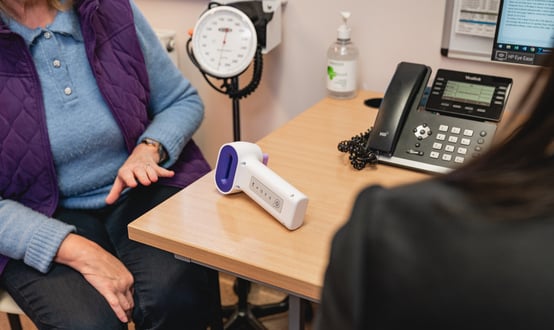Sharing and caring
- 3 June 2014

Encouraging the different organisations that make up the NHS to share information, and to create a ‘seamless’ journey for patients in the process, has been a long-standing goal of NHS IT policy.
Before the National Programme for IT was set up, the Information for Health strategy tried to create ‘lifelong’ electronic health records to achieve this; and ran some Electronic Patient Record Development and Implementation projects to show what could be done.
NPfIT itself aimed to create an integrated care record service, with a Summary Care Record to provide access to key patient information to any professional, anywhere.
More recently, the idea of information sharing has been given new impetus, with NHS England issuing guidance on creating an ‘integrated digital care record’ last summer, with tech fund money to back it up.
Three IDCR ‘exemplars’ were announced at the end of bidding for the first round of tech fund money; while both councils and trusts can bid for IDCR projects in the second round of bidding that has just opened.
From a slightly different direction, the idea of information sharing has also been revived with the government’s revived interest in integrated care; in the specific sense of getting health and social care to work together.
Care minister Norman Lamb, who the NPfIT years arguing for interoperable systems to support local information sharing, has found cash to support 14 integration ‘pioneers’ – some of which put plans for shared records in their proposals.
Doing IT for themselves
As national interest in information sharing has waxed and waned some healthcare communities have got on with their own projects.
The result is a patchwork of initiatives, some of which have made more progress than others, while coming up with different answers to key questions, such as who should hold the record, and what technology should be used to provide access.
In Liverpool, for example, the iLinks programme has spent a decade giving an increasingly wide range of clinicians access to patient information based on GP records, using the EMIS Web-based portal that evolved into the Medical Interoperability Gateway.
Access is covered by information sharing agreements, backed up by patient consent, and has been used to support initiatives ranging from the development of new community services to giving some hospital clinicians access from their own systems.
Next in line is a much wider project across health and social care, says Kate Warriner, deputy director at Informatics Merseyside; the information exchange programme, which will launch at the iLinks conference in July.
“We’ve had lots of experience in relation to data sharing. In the last ten months, we have been using that to create what we are branding iLinks information exchange programme, which is about sharing patient information across the health and social care economy,” she says. “The goal is to give clinicians a full view of an individual.”
Another information sharing project that has made use of the MIG is the Oxford Care Summary although, unusually, it has grown out of the acute sector, rather than from primary care.
The OCS was created by Oxford University Hospital’s IT team, and is hosted on the trust’s ‘case notes’ system; a clinical intranet that holds results and documents.
GPs have been able to use the OCS for 20 years to view pathology results. But over the years, its scope has widened to include demographics, allergies, medications, encounters, care plans and investigations; with information delivered to acute, community and GP staff on a ‘read only’ basis with patient consent.
Shared records and portal projects
Other healthcare communities have taken a very different approach, creating their own shared records. In Hampshire, for example, different organisations have been working since 2005 on the Hampshire Health Record, using Graphnet technology.
The record includes demographics, medication, allergies, GP diagnoses, care encounters, blood and radiology results, clinic letters, discharge information and some social care information. It can be accessed by a wide range of staff, including clinicians at University Hospitals Southampton NHS Foundation Trust.
Dr Amir Mehrkar, the lead clinician on the project that is now lead by NHS South Commissioning Support Unit, says the record has improved decision making, cut the number of unnecessary blood and radiology tests ordered, and improved patient experiences; saving “millions of pounds” in the process.
Meanwhile, in Bristol, 13 organisations across health and social care got together in early 2011 to figure out how they could share information across acute, mental health, ambulance, GPs, community and social care.
Three years later, the first phase of the Connecting Care project is up and running, using a portal from Orion Health to give people access to information. At the moment, systems from the acute, mental health and social care sector feed real time information into a clinical data repository.
Staff can access a range of patient information, from allergies and medications to lab results and social care plans, depending on what kind of access they are authorised to have.
In A&E, Dr Simon Odum, a clinician at North Bristol NHS Trust, says this saves a lot of time phoning GPs for information, and potentially patient lives. “We want to get to where we have admitted a patient for 24 hours the GP can immediately see what we’ve done to that patient,” he adds.
All the same issues
Yet further information sharing approaches are available. Some healthcare communities are running small-scale, pilot projects, using proprietary technologies.
Others are persisting with the Summary Care Record, which NHS England insists is still a “key building block” for the creation of an IDCR, and which it wants to see augmented with end of life care information, immunisations, and significant past problems and procedures.
Despite this, there are some common themes to all these projects. With the notable exception of Oxford’s OCS, they tend to start with the same basic set of information – demographics, medications and allergies, and then add in end-of-life or care plans and / or access to hospital tests and documents.
Yet there is widespread agreement that a critical mass of patients must be covered, and that a significant amount of clinical information must be available for these projects to take off; otherwise clinicians are unlikely to spend valuable time checking whether a record is available.
At the same time, access has to be easy – Dr Mehrkar says enabling Southampton General’s clinicians to access the Hampshire Health Record from their own electronic patient record has been “key” to growth and to getting to all-but unprecedented 8,500 unique users.
This may be one reason that so many national and local projects have failed over the years; they never managed to cover enough people, include enough information, and get well enough embedded into local workflows to succeed.
The latest round of IDCR exemplars and integration pioneers will need ambition from the outset. But if there is another common theme to come out of established information sharing projects it is that they need time and commitment.
Hampshire has been working on its record for almost a decade; Liverpool has been working on its MIG-based system for at least half of one. Two of NHS England’s IDCR exemplars, another well-known MIG-based project in Cumbria, and the Bristol programme, have been going for almost as long.
While information sharing may be essential for creating more ‘joined up’, efficient and high quality health and social care services, it is not a quick fix; just as the cash-strapped NHS and even more cash-strapped local government could really do with one.
Getting people on board
One reason that information sharing projects take so long is sorting out information sharing agreements.
Liverpool has had to get an information sharing agreement in place for every service given access to some or all of the GP summary information available; although Warriner says this has become faster and easier as the idea has become accepted.
Andy Chivers, an Oxford GP and chair of the project board for the OCS, says it “took a long time” to convince GPs to share their data and some are still holding out.
“It took a year to get to 85%, and the remaining 15% are actively saying ‘no’ or ‘it’s a bit too scary’,” he says, adding that his team is planning to get hospital clinicians to write to GPs when a patient is referred without a record, so they can understand the impact of their decision on the information that is available to others treating their patients.
Another, big issue is the one that effectively stalled the SCR for many years; patient information and consent. The SCR was planned on an ‘opt-out’ model, with patients given the chance to say ‘no’ to having an SCR created, after a local patient information campaign.
But medical and privacy groups objected, arguing that patients should ‘opt-in’ instead. In the end, the present government gave the go-ahead for the SCR on this basis, and many other information sharing projects have taken a similar approach.
In Hampshire, for example, a PIP was run for the Hampshire Health Record, although consent is also required at the point of care.
Around 8,600 local patients have opted out. In Oxford, again, Chivers says consent has been “extraordinarily difficult” but the team has done “everything reasonably possible to tell people about it” including running ads on buses and radio.
These kinds of issues have led some to argue that NHS England could usefully switch its attention from encouraging people to run information sharing projects to creating resources that would make them easier to implement and more likely to succeed.
These might include sample business cases, data sharing profiles, and model information sharing and consent agreements.
Time to be ambitious
There are some other weaknesses with existing information sharing projects. Patients, for example, may consent to their records being shared, but they don’t seem to be able to do much else with them; more access, and more usefulness might create an additional ‘push’ for their creation.
And there is surprisingly little published evaluation of what works, and what it delivers. Despite this, the commitment and enthusiasm of those involved remains impressive.
Warriner says: “You need to have ambition. There are too many pilots going on in the NHS. Ambition at scale is a challenge that you have to work through; but it is important.”




